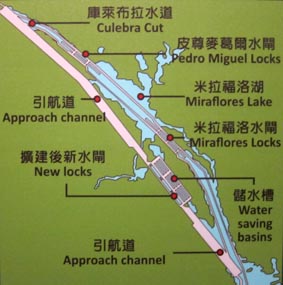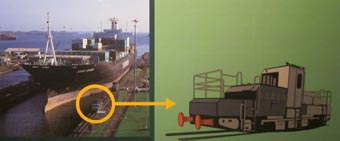一枚の特選フォト「海 & 船」
One Selected Photo "Oceans & Ships"
Back to: Top Page |
2016年に開通したパナマ拡張運河/ミラフローレス閘門(模型) [長榮海事博物館]
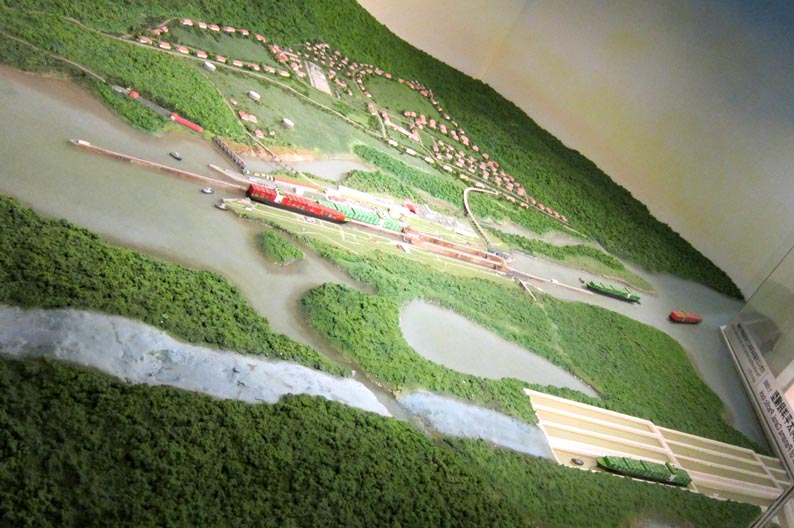
|
台湾の長榮海事博物館 Evergreen Maritime Museum (台北市) に展示されるパナマ拡張運河のミラフローレス閘門 Miraflores Lock
(太平洋側) のジオラマ模型 (縮尺=1:1000) である。画像上方の閘門が従前からある閘門である。画像下方のそれが、2007年に
拡張工事が着工され、2016年6月に開通した新閘門である。そして、グリーンカラーのコンテナ船の上部に見えるのは節水槽 (横3列×縦3列、
9基の節水槽 water saving basins) である。従前のパナマ運河では毎年12,000隻ほどの船舶が通航していた。太平洋・
大西洋の両岸にある閘門での船舶の通過のたびに、人工湖のガトゥン湖の膨大な貯水量が消費される。水資源の使用量を少しでも節約する
ために工夫された新規構造物がそれらの節水槽である。
フランスのレセップスはかつてスエズ運河建設で培った経験を活かしてパナマ運河を建設しようとしたが、 熱帯ジャングル環境であったこと、黄熱病やマラリアのような熱帯病に阻まれもして、工事は難航を極めた。また財政難にも陥り、建設を 完遂することができず中途で放棄した。紆余曲折の末1904年に建設を引き受けた米国は、先ずは建設現場の衛生環境を整え、また運河 水面の高さと海水面のそれとを同じにする海面方式の構造設計を取り止めて「水の階段」方式を採用した。そして、ついに1914年の完成に 漕ぎ着けた。 運河拡張プロジェクトは2007年に始まり、2016年6月に9年を費やして完成した。新閘門を通航できる船舶の大きさの上限は、 長さ366メートル、幅49メートル、喫水15.2メートルである。新しい運河閘室は、コンテナ船について言えば、20フィートコンテナ積載 換算で14,000個のコンテナを積載する船舶をも通航させることができる。 従前の運河では通航できる船舶のタイプとサイズに制約があった。閘室の制約上から、長さ294.13メートル超、幅32.3メートル超の 船は通航できなかった。 また、熱帯淡水満載吃水線は12.04メートルを超えることができなかった。この最大限界ぎりぎりの船は「パナマックス船」と呼ばれた。 そして、この限界を超える船は「ポストパナマックス船」と呼ばれていた。 新閘室が完成した現在では、全長366メートル、幅49メートル、喫水15.2メートルの最大限界ぎりぎりのコンテナ船は「ネオ・パナマックス船」 と呼ばれる。 従前の閘門で船舶を通航させる補助手段としてウォータートラクター (water tractors) が用いられたが、新閘門ではタグボートが 用いられる。なお、展示のジオラマ模型には以下のような説明が付されている。
The Panama Canal cuts across the Isthmus of Panama to connect the Atlantic Ocean to the Pacific Ocean. Often referred to as the "World's Bridge", the Panama Canal makes it unnecessary for ships traveling between these two great oceans to sail all the way around South America. The Panama Canal is now the busiest canal in the world, and every year, approximately 12,000 ships pass through.
1880: The Birth of the Panama Canal
1914: The U.S. takes over the construction of the Panama Canal
2016: The Expansion of the Panama Canal is completed in 2016. Due to its narrow channel in the past, there were certain restrictions on the type and size of the ships transiting the Panama Canal. Generally speaking, the length should not exceed 294.13 meters, the width should not exceed 32.3 meters, and the tropical fresh water draught should be about 12.04 meters; this kind of ships is called the Panamax ship. Ships larger than this standard are called Post-Panamax ships. Within the limits (Length 366 meters; width 49 meters; and draught 15.2 meters) of the new water locks in Panama Canal, the largest container ships that could go through are called the "Neo Panamax". The original Panama Canal water locks have to use water tractors to assist vessels to go through. The new water locks, on the other hand, use tug boats to operate this mission. The Panama Canal is a vital waterway connecting the Pacific and the Atlantic Ocean. However, the two ocean surfaces are not on the same level which caused ships difficult to pass through. Therefore, the engineers designed a system called 'water staircase' to allow ships to cross the Isthmus of Panama safely. The water staircase consists of gigantic water gates 'locks' with different heights. When the gate closed, the water flowed to lower lock to make the water surface even allowing ships to go through, which seems like climbing the stairs.
Current Locks: The capacity of the older water lock chambers can allow 4,400 TEU container ships to pass through.
|
1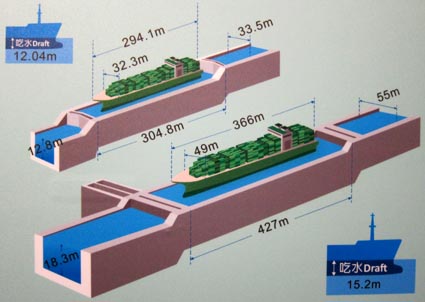 新旧閘門の大きさと通航可能最大船舶の大きさ。 [拡大画像: x27488.jpg]
長さ294.1m、幅32.3m、喫水12.04m なお、既存の閘室の大きさ: 長さ304.8m、幅33.5m、深さ12.8m
* ネオパナマックスサイズの船舶(新閘門を通航可能な最大の船):
2
3
5 |
Back to: Top Page |
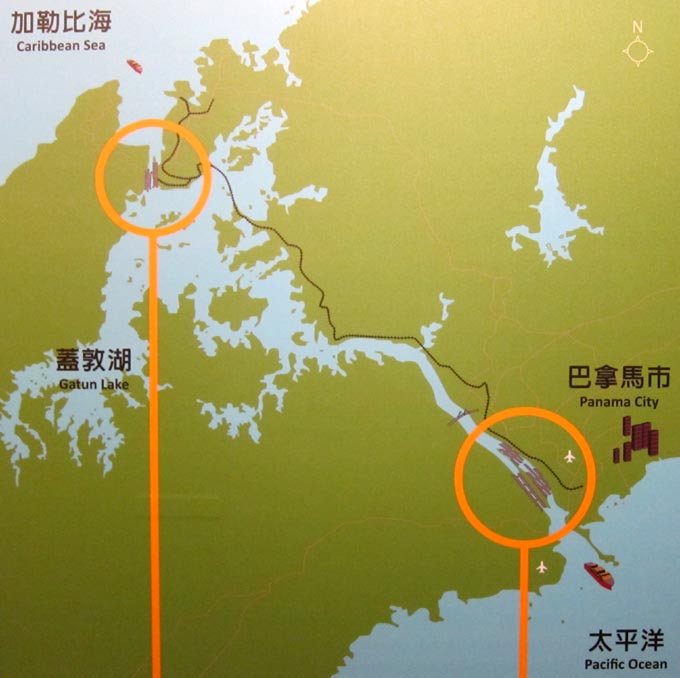
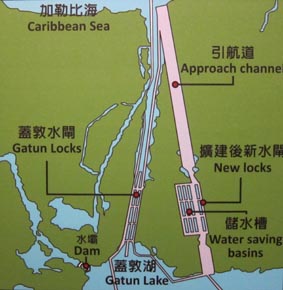 4
4